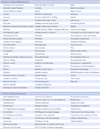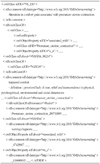Abstract
Purpose
This study was performed to propose an ontology methodology based on standardized nursing process as framework in obstetric and gynecologic nursing practice.
Methods
The instrument used in this study was based on the nursing diagnosis classification established by North American Nursing Diagnosis Association (NANDA) (2009-2011), fifth edition of the Nursing Interventions Classification (NIC) (2008), forth edition of the Nursing Outcomes Classification (NOC) (2008) developed by Iowa State University and systematized nomenclature of medicine clinical terms (SNOMED CT). The nursing records data were collected from electronic medical records of one hospital from August to October 2010.
Results
One hundred and forty-one nursing diagnosis statements used in obstetric and gynecologic nursing unit were linked standardized nursing classifications and constructed nursing diagnosis ontology including interoperability.
Conclusion
Not only will this result be helpful to complete nurse's lack of knowledge and experience, it will also help to determine nursing diagnosis logically by using standardized nursing process. It will be utilized as the method to construct ontology including interoperability in other nursing units. It will be presented nursing interventions according to nursing diagnosis and thus will be easier to establish nursing planning. This can provide immediate feedback of the nursing process application.
Figures and Tables
Notes
Summary Statement
▪ What is already known about this topic?
Nursing process is the common guideline uniting different types of nurses who work in varied areas and essential core of nursing practice. Nonetheless, nurses' do not use nursing process for various reasons.
▪ What this paper adds?
Knowledge system about nursing process in obstetric and gynecologic nursing unit was constructed using a standardized nursing process and SNOMED CT. It's constructed based on the ontology;and will be reused in other clinical terms and nursing units.
▪ Implications for practice, education and/or policy
Not only it will be helpful to complete nurse's lack of knowledge and experience to determine nursing diagnosis logically, but will be easier to establish nursing planning andnursing interventions according to nursing diagnosis.
References
1. Benson T. Principles of health interoperability HL7 and SNOMED. 2010. London: Springer.
2. Bluechek GM, Butcher H, Dochterman JM, editors. Nursing interventions classification (NIC). 2008. 5th ed. St louis: Mosby Elsevier.
3. Chi SA, Choi KS, Park KS, Jung YK. A basic study on improvement and computerization of nursing record. J Korean Acad Nurs. 1999. 29:21–33.

4. Chin HJ, Kim SG. Standardization of main concept in chief complaint based on SNOMED CT for utilization in electronic medical record. J Korean Soc Med Inform. 2003. 9:235–247.

5. Clinical Information Consultancy. Viewing SNOMED clinical terms with CliniClue Xplore. 2011. Retrieved November 15, 2012. from http://www.cliniclue.com/.
6. Din MA, Abidi SS, Jafarpour B. Ontology based modeling and execution of nursing care plans and practice guidelines. Stud Health Technol Inform. 2010. 160:1104–1108. http://dx.doi.org/10.3233/978-1-60750-588-4-1104.
7. Hardiker NR. Mediating between nursing intervention terminology systems. Proc AMIA Symp. 2001. 239–243.
8. Hardiker NR. Logical ontology for mediating between nursing intervention terminology systems. Methods Inf Med. 2003. 42:265–270.

9. Johnson M, Moorhead S, Bulechek GM, Butcher HK, Maas ML, Swanson E. NOC and NIC linkages to NANDA-I and clinical conditions: Supporting critical reasoning and quality care. 2012. 3rd ed. St. Louis: Mosby Year Book.
10. Kim HS. Development and application of a computerized nursing process program for orthopedic surgery inpatients-NANDA, NOC, and NIC linkages. J Korean Acad Nurs. 2005. 35:979–990.
11. Kim H, Harris MR, Savova GK, Chute CG. The first step toward data reuse: Disambiguating concept representation of the locally developed ICU nursing flowsheets. Comput Inform Nurs. 2008. 26:282–289. http://dx.doi.org/10.1097/01.NCN.0000304839.59831.28.
12. Kim JA. Development of knowledge management system of nursing process for clinical application. 2000. Seoul: Yonsei University;Unpublished doctoral dissertation.
13. Kim JH, Lee JH, Park HA, Choi HW, Kim MK. Development of ontology for nursing statement. J Korean Soc Med Inform. 2005. 11:63–65.
14. Kim PJ. Application model of the nursing process to electric medical records for cardiovascular patients. 2006. Seoul: Yonsei University;Unpublished doctoral dissertation.
15. Kim SH, Han SB, Choi J. The expressive power of SNOMED-CT compared with the discharge summaries. J Korean Soc Med Inform. 2005. 11:265–272.

16. Lee E, Park H. Korean nurse's experiences: The influence of NNN (NANDA-I, NIC, NOC) terminologies on nursing workflow. AMIA Annu Symp Proc. 2008. 1083.
17. Moorhead S, Johnson M, Mass M, Swanson E, editors. Nursing outcomes classification (NOC). 2008. 4th ed. St Louis: Mosby Elsevier.
18. NANDA International. Nursing diagnoses: Definitions & classification, 2009-2011. 2009. West Sussex: Wiley-Blackwell.
19. Park HJ. Development and application of the computerized nursing process program using nursing diagnosis-outcome intervention (NANDA-NOC-NIC) linkage. 2003. Gwangju: Chonnam National University;Unpublished master's thesis.
20. Park MJ. Identification of nursing diagnosis-outcomeintervention (NANDA-NOC-NIC) linkage in MICU inpatients. 2010. Gwangju: Chonnam National University;Unpublished doctoral dissertation.
21. Scroggins LM. The developmental processes for NANDA international Nursing diagnoses. Int J Nurs Terminol Classif. 2008. 19:57–64. http://dx.doi.org/10.1111/j.1744-618X.2008.00082.x.

22. Stanford University. Protege 3.4.7. 2011. Retrieved October 20, 2012. from http://www.stanford.edu/.
23. von Krogh G, Dale C, Naden D. A framework for integrating NANDA, NIC, and NOC terminology in electronicpatient records. J Nurs Scholarsh. 2005. 37:275–281. http://dx.doi.org/10.1111/j.1547-5069.2005.00047.x.




 PDF
PDF ePub
ePub Citation
Citation Print
Print







 XML Download
XML Download